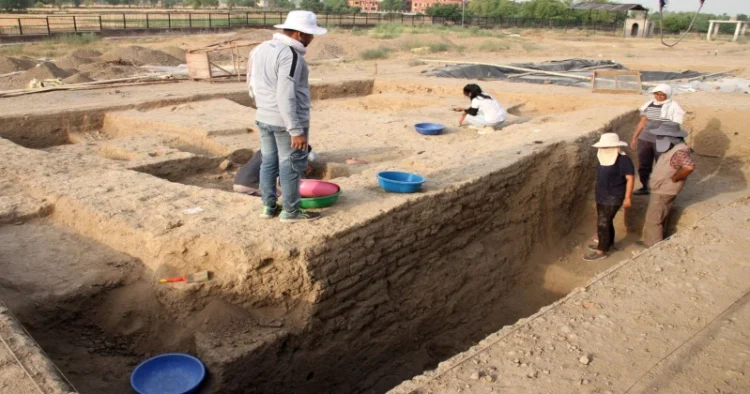The Archaeological Survey of India (ASI) has embarked on a significant mission to unravel the historical mysteries of the Braj region, renowned as the birthplace of the Hindu deity Krishna. After a hiatus of five decades, the ASI has resumed excavation activities at Govardhan Hill, a pivotal site in the Braj region, which encompasses Mathura, Vrindavan, and other locations mentioned in the Hindu epic Mahabharata.
Located in the Jat-dominated village of Bahaj in the Deeg district of Rajasthan, bordering Uttar Pradesh, Govardhan Hill holds immense religious and historical significance. Legend has it that Bhagwan Krishna lifted Govardhan Hill with his little finger to shelter the villagers from a storm, adding to its mythical allure.
Vinay Kumar Gupta, the superintending archaeologist of ASI’s Jaipur circle, leads the excavation efforts, aiming to delve into Mathura’s ancient past and surrounding areas. Gupta highlights the importance of Braj in Indian culture, noting its influence on the worship system and sculpture art of Hindu deities.
The excavation at Bahaj village is part of the Union Government’s broader agenda to explore the country’s ancient roots and uncover evidence related to the Mahabharata period. Bahaj village, situated at the base of Govardhan Hill, provides a unique opportunity to study the ancient culture of Mathura. Despite being a thriving settlement, Bahaj has retained its archaeological significance, attracting scholars and researchers nationwide.
Prime Minister Narendra Modi’s administration has shown a keen interest in deepening the understanding of India’s civilisational history, as evidenced by recent initiatives like the underwater exploration at Dwarka.
Gupta and his team have made significant discoveries since the excavation began in January. These findings include bone tools from the Shunga Period, clay seals depicting deities atop elephants, and artefacts dating back to the Mauryan phase. Additionally, unearthing burnt bricks resembling those from the Mauryan era has generated considerable excitement among archaeologists.
Earlier, Excavations at Rakhigarhi also revealed various occupational phases beginning from the Early to mature Harrapan period, covering the time from 5th millennia BCE to 3rd millennia BCE based on the radiocarbon dates obtained from various layers. Rakhigarhi site spanning eleven mounds is spread across nearly 350 hectares, covering the present villages of Rakhi Khas and Rakhi Shahpur in Hisar in Haryana.
In 2021, archaeologists discovered eleven mounds in total at Rakhigarhi, which have been named RGR-1 to RGR-11. Until then, Mohenjo Daro, which covers 300 hectares, was considered the largest Harappan metropolis in south Asia. The Rakhigarhi site ranks among one of the “five iconic sites” declared by Union Finance Minister Nirmala Sitharaman during her budget speech in February 2020. The other sites are Hastinapur in Uttar Pradesh, Sivasagar in Assam, Dholavira in Gujarat and Adichanallur in Tamil Nadu. Nirmala Sitharaman also announced the government’s decision to fund five on-site museums, including the under-construction museum launched by the Haryana government at Rakhigarhi.
In 2022-23, ASI sanctioned excavations at 51 sites nationwide to unearth ancient cultures. In Benwa village, Sikar, Rajasthan, pottery shards dating back to possibly the early Harappan civilisation (3300 BCE to 1300 BCE) were discovered. Meanwhile, excavation aims to uncover evidence from the ‘Mahabharata period’ (estimated 900 BCE to 1000 BCE) in Delhi’s Purana Qila complex, as per veteran archaeologist BB Lal.
One of the most remarkable discoveries at the site is the presence of miniature pots filled with natural sand, a practice previously unseen in Indian archaeology. These pots, found across different layers of the excavation site, shed light on the pottery-making traditions of the region.
The excavation also unearthed hundreds of small beads, indicating local craftsmanship and trade networks. Gupta speculates that the raw material for these beads might have been sourced from Gujarat, suggesting ancient trade connections.
The ASI’s presence in Bahaj village has garnered significant attention from the local community, with villagers closely observing the excavation activities. Despite initial challenges, including overcrowding at the site, the ASI team has persevered to uncover Mathura’s ancient past.
The ongoing excavation at Bahaj village holds immense promise for understanding the early settlement patterns and cultural evolution of the Braj region. With each discovery, archaeologists inch closer to unravelling the mysteries of Mathura’s rich heritage.
As the excavation continues, Gupta and his team remain committed to exploring the depths of history buried beneath the layers of time.



















Comments